AMD’s Radeon HD 6870 & 6850: Renewing Competition in the Mid-Range Market
by Ryan Smith on October 21, 2010 10:08 PM ESTLast but not least in our look at AMD’s new Radeon 6800 series is our look at power consumption, GPU temperatures, and the amount of noise generated. With efficiency being one of the major design goals for Barts, AMD stands to gain a lot of ground here compared to the 5800 series for only a minor drop in performance.
Looking quickly at the voltages of the 6800 series, we have 4 samples – 2 each of the 6870, and 2 each of the 6850. Both of our 6870 cards have an idle voltage of 0.945v and a load voltage of 1.172v, and seeing as how they’re both based on AMD’s reference design this is what we would expect for a design that is based around a single VID.
However our 6850 results, which include a non-reference card in the form of XFX’s customized 6850, are much more interesting. While our reference 6850 has a load voltage of 1.094v, our XFX card reports a load voltage of 1.148v. We’ll be taking a look at the XFX 6850 in-depth next week in our 6850 roundup, but for now this leaves us with the question of whether AMD is using variable VIDs, or if XFX is purposely setting theirs higher for overclocking purposes.
| Radeon HD 6800 Series Load Voltage | |||||
| Ref 6870 | XFX 6870 | Ref 6850 | XFX 6850 | ||
| 1.172v | 1.172v | 1.094v | 1.148v | ||
Finally our EVGA GTX 460 1GB FTW card has a VID of 0.975v, which compared to all the other GTX 460 cards we’ve tested thus far makes it quite notable. This is lower than any of those other cards by 0.012v, a property we believe is necessary to sell such a heavily overclocked card without causing a similarly large rise in power/heat/noise. It’s also for this reason that we question whether NVIDIA could actually supply suitable GF104 GPUs in high volumes, as GPUs capable of running at this voltage are likely coming from the cream of the crop for NVIDIA.
For our tests, please note that we do not have a pair of reference 6850s. For our second 6850 we are using XFX’s customized 6850 card, which means our results will undoubtedly differ from what a pair of true reference cards would do. However as the 6850 reference design will not be widely available this is less important than it sounds.
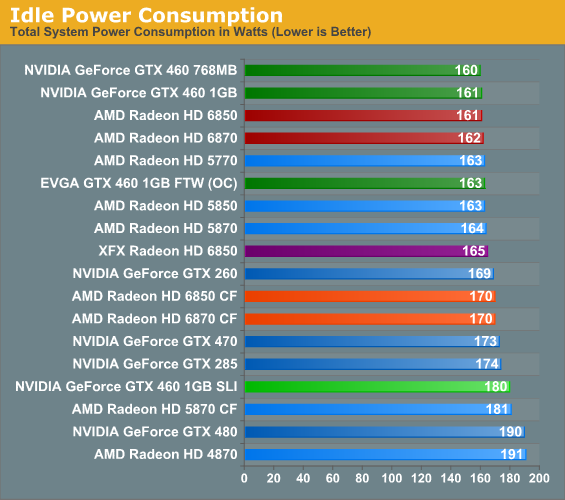
As always we start our look at power/temp/noise with our look at idle power. Because we use a 1200W PSU in our GPU test rig our PSU efficiency at idle is quite low, leading to the suppression of the actual difference between cards. But even with this kind of suppression it’s still possible to pick out what cards have a lower idle power draw, as the best cards will still result in a total system power draw that’s at least a couple of watts lower.
AMD’s official specs call for the 6800 series to have a lower idle power draw than the 5800 series, and while we can’t account for all 8 watts we do manage to shave a couple of watts off compared to our 5800 series cards. The Crossfire results are even more impressive, with the 6870CF drawing 11W less than the 5870CF.
Compared to the 6800 series the GeForce GTX 460 768MB does manage to hang on to top honor here for a single card by a watt, however in SLI our 1GB cards do worse than our 6800 series cards by 10W.
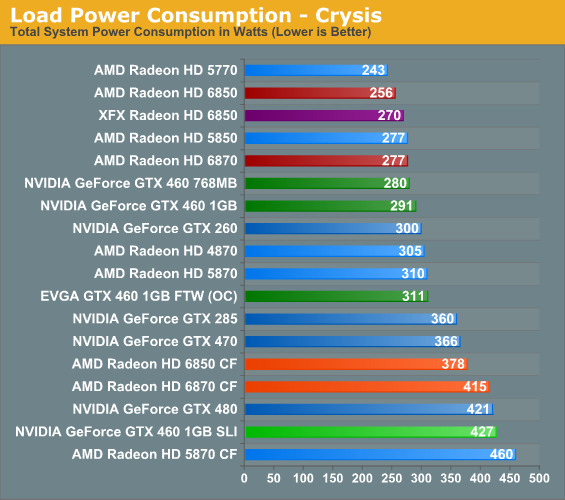
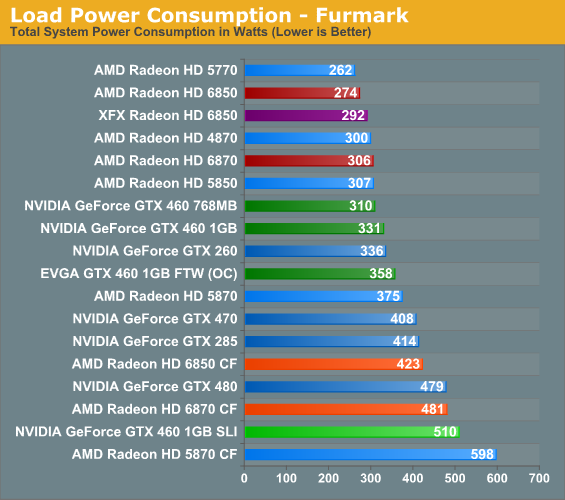
Looking at load power consumption it’s clear from the start that AMD’s efficiency gains are going to pay off here. On the latest iteration of our power consumption chart the 6850 underconsumes even the already conservative 5850 by 20W under Crysis and 25W under FurMark, showcasing how AMD was able to reduce their power consumption by a significant amount while giving up much less in the way of performance.
Compared to the 6800 series NVIDIA does notably worse here, with all of the GTX 460 cards pulling down more power than the 6870 and the GTX 470 being in a league of its own. While NVIDIA was competitive with Cypress on power, they’re not in a position to match Barts. They can deliver Barts-like performance (and then some), but they have to consume more power to do it.
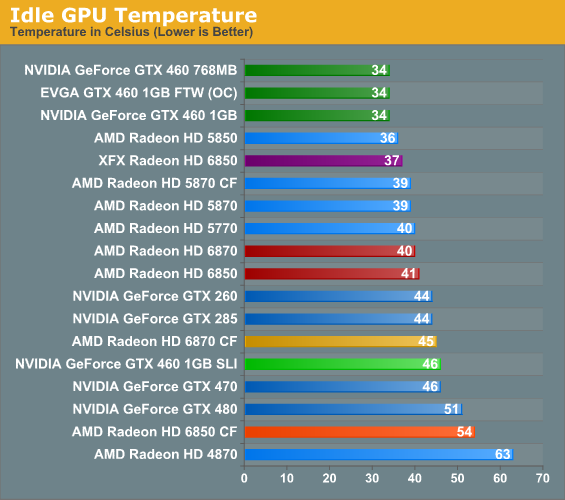
Up next is our look at GPU temperatures, starting with idle temps. As we mentioned in our GTX 460 review, NVIDIA ended up producing a very effective reference cooler for the GTX 460, utilizing an open-air design that by dissipating air inside and outside of the case is capable of reaching temperatures fully exhausting coolers can’t match. As a result all of the GTX 460 cards top our charts here.
Prior to the GTX 460 series this is a metric the 5850 always did well in, so we had expected a similar performance from the 6850, only to leave disappointed. What we’re ultimately looking at is a matter of the quality of the cooler: the 6850 may consume less power than the 5850 at idle, but it packs a weaker cooler overall, allowing it to approach these temperatures. For a gaming card such as the 6800 series idle temperatures are almost entirely superficial once we get below 50C, but even so this tells us something about the 6850 reference cooler.
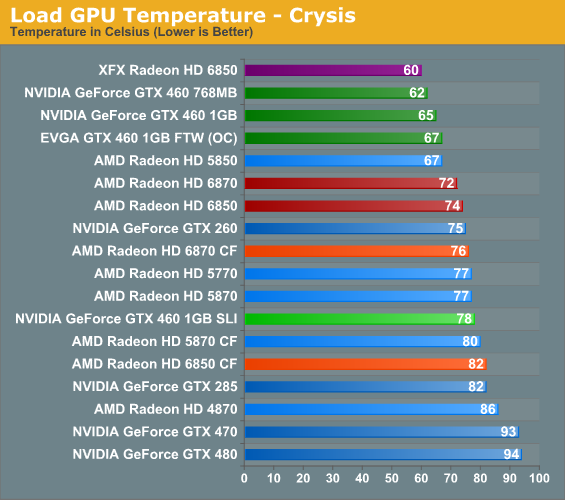
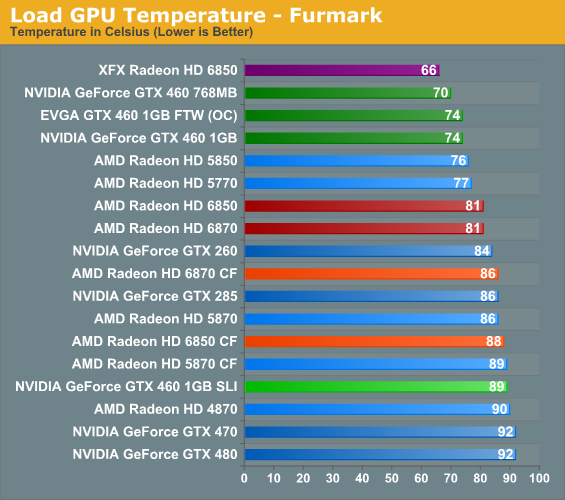
Thanks to the GTX 460’s open-air cooler, all of our GTX 460 cards top our temperature chart even with their higher power consumption. The trade-off is that all of these cards require a well-ventilated case, while the Radeon 5800 and 6800 series will tolerate much poorer cases so long as there’s enough ventilation for the card to pull in air in the first place.
As was the case with idle temperatures, the reference 6850 ends up doing worse than the 5850 here thanks to its less effective cooler; however the 6870 ends up doing better than both the 6850 and 5870 due to its more effective cooler and its lower power consumption compared to the 5870. While these cards can’t quite touch the GTX 460 series, we’re still looking at some of the coolest cards among our current benchmark suite.
Meanwhile our XFX 6850 ends up doing the best out of all of our cards here, however this will come at a cost of more noise. We'll touch on this more next week in our 6850 roundup.
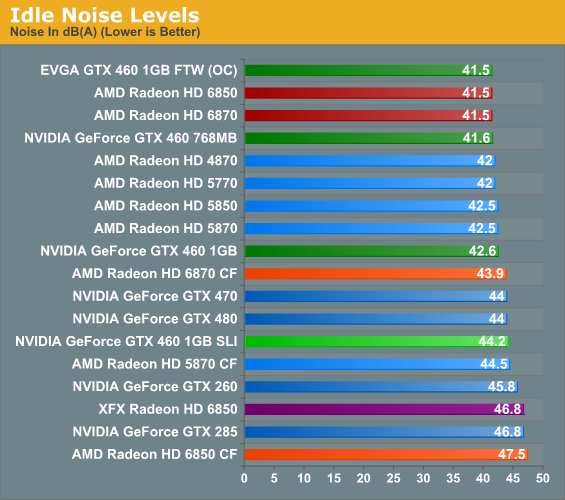
Last but not least is idle noise, which isn’t much of a story with modern cards. With the exception of the GTX 470/480, the latest GeForce and Radeon cards are both capable of running up against the noise floor of our testing environment.
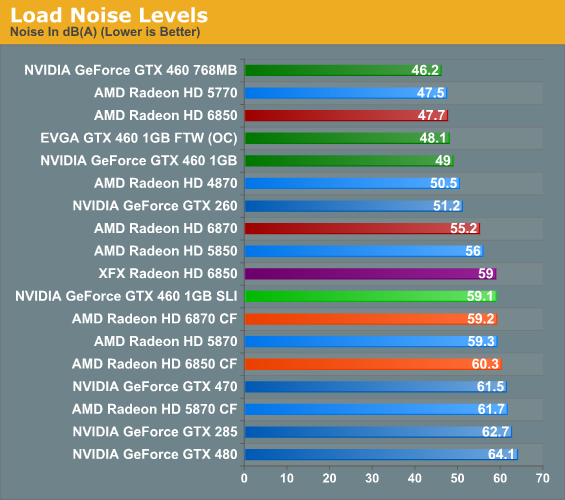
Under load we once again see an NVIDIA GTX 460 card top the chart thanks to its open-air design. This is followed very closely however by the Radeon 6850, which at 47.7dB is our third-quietest card and finally showing off the advantages of the tradeoffs AMD made with the reference cooler. The 6850 may not be as cool as the 5850, but it’s quite a bit quieter. As for the XFX card, this is where XFX has to pay the piper, as their 6850 card ends up being as loud as a 5870 in exchange for their lower temperatures.
Meanwhile the 6870 ends up being quite a bit louder than both the GTX 460 series and the 6850, coming in at 55.2dB. This is a definite leg-up compared to the 5870 and nicely cements the fact that the 6870 is intended to be the 5850’s replacement, but it means the GTX 460 series spoils the results here. Once custom-design vendor cards come out for the 6870, I suspect we’re going to see someone quickly sell a 6870 with a less aggressive cooler, which for the costs of higher temperatures would afford less noise.










197 Comments
View All Comments
529th - Saturday, October 23, 2010 - link
the marketers wanted to differentiate themselves from Nvidia, that's why they are using their second place cards to be in the same category as nvidias second place cardsIf you are shopping for a top of the line card you should know atleast a little bit about them although the un-educated video-card shopper would think that a 470 and 5870 or 6870 is on the SAME performance level, WHICH ISN'T TOO FAR FROM THE TRUTH, but I think it's here where AMD marketers are trying to make a statement
i could be wrong, i have had very little sleep last night, cedar point was a blast!
SininStyle - Saturday, October 23, 2010 - link
Can I just say THANK YOU for adding a OC edition of the 460. Don't know why everyone is whining. If you don't want to know how an OC edition compares then ignore the stupid bench for it. Why is such a huge deal?I personally am glad they included it and this is why. The 460 1gb stock is 675mhz and can OC "reliably" to 850mhz.. That's 175mhz gain and its noticeable. Stock volt stock fan. And for those that wanna claim heat, mine shows 64c at 75% fan on OCCT. The 6870 get 50hz OC at stock volt/fan. SEE why this is important people? $180 vs $240 with same results.
Now with volt changes I'm sure they both have room to go I'm not sure how much. I tend to shy away from higher voltages at least for now.
The 6850 is the better buy between the 2 68xx cards. That has allot of headroom to OC. That would even be a better comparison to the 460 due to the price. And owning the 460 doesn't make me a fanboy and I will say you can flip a coin for value on these 2.
So again thanks for the added information. Cant see why anyone would complain about more info. If you don't like the info ignore it if it makes you feel better. Feel free to add OCed 6850s and 6870s I look forward to the comparison.
Parhel - Saturday, October 23, 2010 - link
"The 460 1gb stock is 675mhz and can OC "reliably" to 850mhz"No, it absolutely cannot. the FTW card is a "golden sample" which is why there are so few available. Stock cooling on a stock card will not get you to 850Mhz with 24/7 reliability. You *might* get to 800Mhz, probably a bit less. That's a great value, IMO. If I were in the market at the moment, I'd pick a base model GTX 460 and OC it. Not arguing that point at all. But presenting this card in the 6870 launch article is a sham and major black eye to Anandtech's credibility.
rom0n - Saturday, October 23, 2010 - link
Is it possible to post the GPUZ of the HD6850. It seems there are numerous cases where HD6850 has 1120 sent out to reviewers. Seehttp://benchmarkreviews.com/index.php?option=com_c... If this happens to be one of them the results may be a little misleading. If not then it'll reaffirm the results.
GullLars - Saturday, October 23, 2010 - link
This means a 6870 with open-air fan optimized for noise will be my early winter solstice present for myself, togheter with the 4x C300 64GB i just got :DI went for a value-upgrade of my old rigg with P2x6 1090T, 8GB kingston value DDR3, and AM3 mobo with SB850, so once i get both the SSD in RAID-0 and the GPU, I'll be a happy camper (or rusher) <3
It'll tide me over untill i can get Bulldozer or a next gen Intel (high end/workstation) around winter 2011/2012.
poohbear - Saturday, October 23, 2010 - link
"Apparently a small number of the AMD Radeon HD 6850 press samples shipped from AIB partners have a higher-than-expected number of stream processors enabled.This is because some AIBs used early engineering ASICs intended for board validation on their press samples. The use of these ASICs results in the incorrect number of stream processors. If you have an HD 6850 board sample from an AIB, please test using a utility such as GPU-z to determine the number of active stream processors. If that number is greater than 960, please contact us and we will work to have your board replaced with a production-level sample.
All boards available in the market, as well as AMD-supplied media samples, have production-level GPUs with the correct 960 stream processors."
so which one did Anandtech get? false marketing is such BS, just wanna be sure your benchmarks for the 6850 are reliable and we're not getting overrated benchmarks due to a cherry picked review sample.
lakrids - Saturday, October 23, 2010 - link
The review ended up looking like an advertisement for EVGA at page 7 and beyond. Why EVGA? Why not some other brand?Why include that brand at all? Just mark the card "GTX 460 OC'd 850MHz".
At the very first benchmark: Crysis 2560x1600, you didn't include the reference GTX 460, you pitched the HD6870 against the EVGA overclocked version. EVGA here, EVGA there, EVGA everywhere.
Would you blame me if I suspect you of being on EVGA's paycheck?
Lolimaster - Sunday, October 24, 2010 - link
When I call you a Intel/Nvidia biased site I'm saying the truth. Are you reviewing the HD6000 or doins an EVGA product reviews.This is an insult.
Message:
Nvidia will disappear like the dodo, just a bit more time and at that time all this sh1t will end.
SininStyle - Sunday, October 24, 2010 - link
You do understand if Nvidia vanishes the price of GPUs goes through the roof right? Nvidia isnt going to vanish any earlier then Radeon. Saying either just translates into "Im a fanboy"Stop defending a sticker and start shopping price performance. Neither company would hesitate to rape your wallet if the other would allow it. Case in point look at the price of the 57xx and 58xx 2 months ago. Then look at the price of the same cards including the 68xx cards now. Any of these cards perform less then they did 2 months ago? But the price is a whole lot cheaper isnt it? Well you can thank the 460 for that. Competition results in better pricing for the same performance. You should be thanking Nvidia not hating them.
Super_Herb - Sunday, October 24, 2010 - link
I love it - "as a matter of policy we do not include overclocked cards on general reviews"..........but this time nVidia said pretty please so we did. But because our strict ethical policy doesn't allow us to include them we'll just tell you we did it this one special time because a manufacturer specifically sent us a special card and then our integrity is still 100% intact......right? Besides, the "special" card nVidia sent us was so shiny and pretty!Back to [H]ard to get the real story.